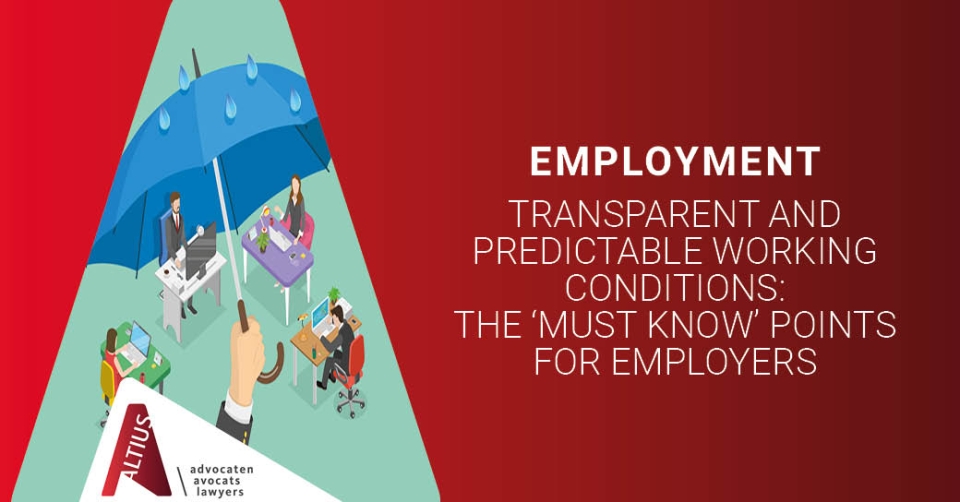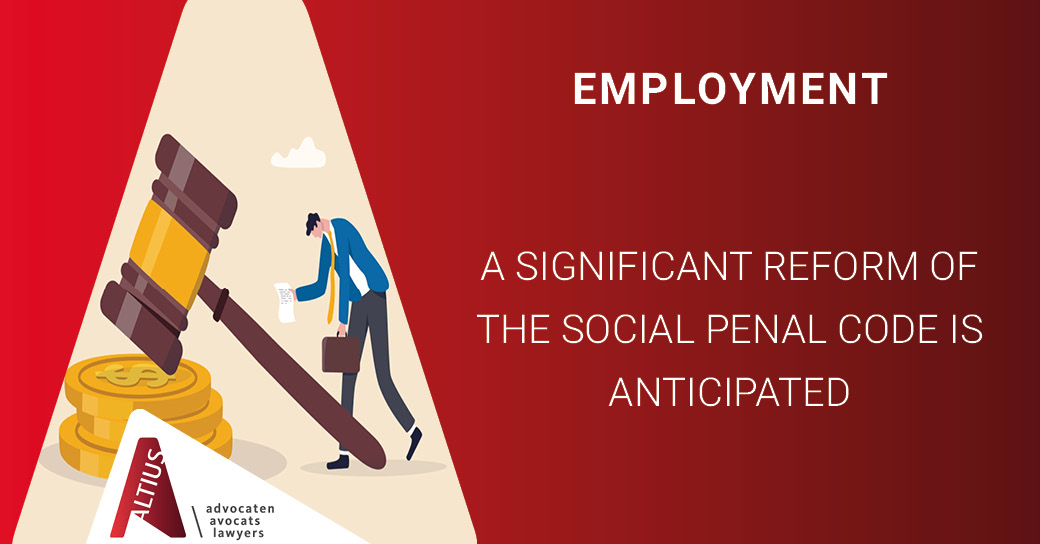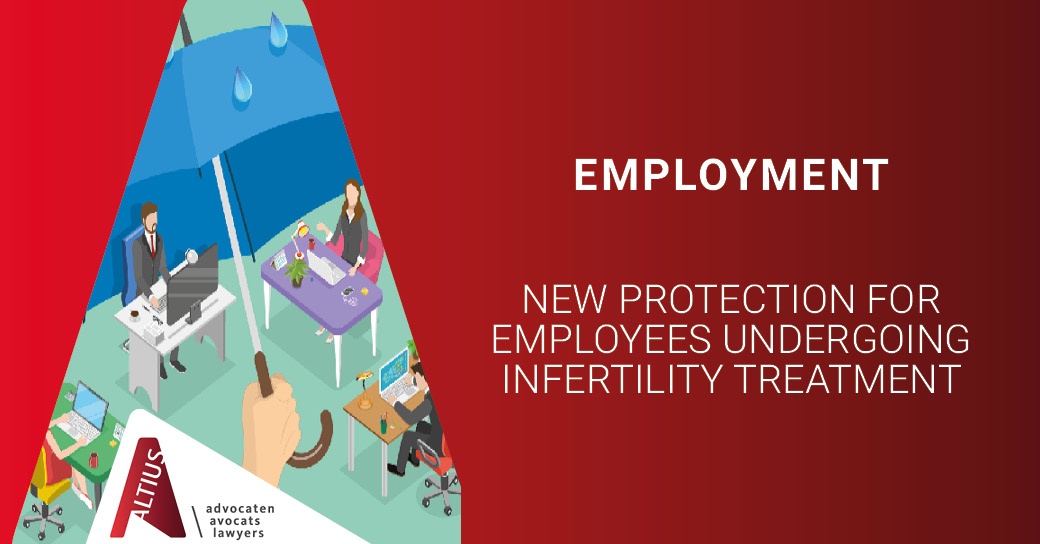Transparent and predictable working conditions: the ‘must know’ points for employers

An EU Directive was published in 2019 that obliges the Member States to guarantee, on the one hand, an improvement in employment conditions by enforcing more transparent and predictable employment conditions, and, on the other hand, increasing the flexibility in the labour market. Belgium has finally transposed this EU Directive with not one but two legal instruments: namely, an Act of 7 October 2022 and a national Collective Bargaining Agreement°161 of 27 September 2022.
This blog series (consisting of 3 parts) focuses on the key points of each of the three main areas brought by the Directive’s implementation in Belgium. In this first blog post, we discuss the right of employees to request a form of employment that is more predictable and secure, which has been laid down in the very recent CBA n°161 of 27 September 2022 and entered into force on 1 October 2022.
This new employee right is explained using the following 10 quick-but-key questions and answers.
No. Only an employee who fulfills the following conditions has the right to request a form of employment that is more predictable and secure:
- the employee is an employee with an employment contract or is an interim worker; and
- has at least 6 months’ seniority (i.e. length of service) with the (same) employer or user; and
- performs more than 3 hours of work per week on average within a reference period of 4 consecutive weeks.
Moreover, for an employee to be eligible for a form of employment that is more predictable and secure, the following conditions must be met:
- a type of work with more predictable and secure working conditions is available in the company;
- the employee must have the necessary qualifications and competences for this type of employment;
- the employee must accept the suggested working time arrangement and salary conditions.
These last three conditions can be modified by a sector-level or company-level CBA, by a company agreement with the trade union delegation or the employees, or by mutual agreement between the employer and the employee.
No. However, the CBA provides in its commentary that, for example, the following employment forms could be considered as being more predictable and secure and can be requested by the employee:
- For employees with a fixed-term employment contract: an indefinite-term employment contract;
- For part-time employees: a full-time employment contract or an employment contract with a higher weekly working time;
- For employees with variable working schedules: fixed working schedules;
- For interim workers with daily contracts: weekly or monthly interim contracts.
However, this list is not exhaustive, and the employee could propose a different form of employment that he/she considers predictable and secure and that he/she considers to be more appropriate.
No. The employee must provide the employer with a written request. Such a written request must:
- include an explicit reference to CBA n°161; and
- state the exact type of more predictable and secure employment preferred by the employee; and
- state the starting date preference; and
must be filed at least 3 months prior to the date that he/she would like this type of employment to start. However, this term can be deviated from by sectoral or company-CBA, company-level or individual agreement.
The employee must send the written request by registered mail or electronically with a proof of receipt from the employer or he/she should hand it over personally to the employer asking the employer to sign a double copy as a proof of receipt.
Yes. The employer should answer the employee’s request within the following time period:
- within 1 month from the date of the employee’s request for an employer with more than 20 employees; or
- within 2 months from the date of the employee’s request for an employer with less than 20 employees.
No. The employer can refuse the employee’s request, after taking into account the company’s needs as well as the employee’s needs; but the employer’s refusal must be justified in writing (e.g. in a letter or by email). For example, an employer’s refusal could be based on one of the following reasons:
- the requested type of employment is not available within the company;
- the employee does not have the necessary qualifications or competences;
- the company’s operational capacity does not allow for such a form of employment.
As an alternative, the employer could make a counterproposal to the employee’s request or postpone the more predictable and secure form of employment that has been requested.
Yes. The employee is protected against:
- Negative action by the employer (such as a demotion, a change of function, a salary reduction, a negative evaluation);
- Dismissal by the employer (including preparatory actions for such dismissal).
The protection above applies from the date of the employee’s request until 2 months after the employer’s refusal or the new form of employment enters into force.
Nonetheless, if the employer would take any negative action towards the employee, then the employer could be held liable to pay damages equal to 2 to 3 months’ salary. If the employer would dismiss the employee, or take preparatory action for such a dismissal, then the employer could be held liable to pay damages equal to 4 to 6 months’ salary. Of course, this will only be the case if the employee invokes facts from which it may be presumed that these negative actions or (the preparation of) the dismissal were based on his/her request for a form of employment that would have been more predictable and secure, without the employer being able to prove otherwise.
If the employee is dismissed or treated negatively for other reasons, then the ‘penalties’ above will not apply.
Yes. The employer can postpone the requested ‘more predictable and secure form’ of employment, provided that there are reasons linked to the good operation of the company’s business that justify such a postponement. The employer should justify such a decision for postponing the request by specifying in writing the exact issues linked to an immediate acceptance.
However, this postponement cannot result in the employee’s taking-up of the more predictable and secure form of employment becoming impossible in practice.
Instead of accepting or refusing the request ‘as is’, the employer can decide to make a counterproposal to the employee, which may contain an adjusted form of more predictable and secure employment. For example, if an employee with part-time employment (of 50%) would ask for a full-time employment (i.e. 100%), then the employer could suggest a part-time employment equal to 80% of a full-time employment instead, because no full-time position is available within the company at that moment.
No. After the employer has accepted the employee’s request, they both should work out an agreement regarding the modalities of the new form of more predictable and secure employment. In this regard, the parties should, among other things, discuss the working time arrangement as well as the salary conditions.
Yes, but the employee can only file a request once in every 12-month period. Only if the employer would not have answered the last request within the agreed term (i.e. within 1 or 2 months, see Question 4), then the employee could repeat his/her request without having to respect this 12-month waiting period.
Conclusion
The EU Directive on transparent and predictable working conditions has finally been transposed into Belgian law by the Act of 7 October 2022 and the CBA n° 161 of 27 September 2022. The CBA entered into force on 1 October 2022. Since that date, employees can ask their employers for a form of more predictable and secure employment.
Please do not hesitate to contact ALTIUS’ Employment team if you would like any further information or if we can assist with employees’ requests regarding a form of more predictable and secure employment.
Written by
Recommended articles
Internal investigations: an employee’s right to be assisted during an interview.
Although employers have been proceeding with internal investigations for decades, nowadays they raise more and more legal questions. Driven by legislative initiatives and case law trends, there are many situations in which an employer may be forced to an internal investigation.
Read onA significant reform of the Social Penal Code is anticipated
A new draft Act has recently been submitted to the Belgian Parliament that aims to amend the Social Penal Code which lists the infringements of labour and social security law that are punishable and the related penalties.
Read onNew protection for employees undergoing infertility treatment
The Belgian Parliament has adopted a new Act to better protect employees undergoing infertility treatment. The new Act aims to protect these employees against (i) dismissal, and (ii) discrimination. It therefore updates two well-known Belgian employment law Acts: the Labour Act of 16 March 1971 and the Gender Act of 10 May 2007.
Read on


